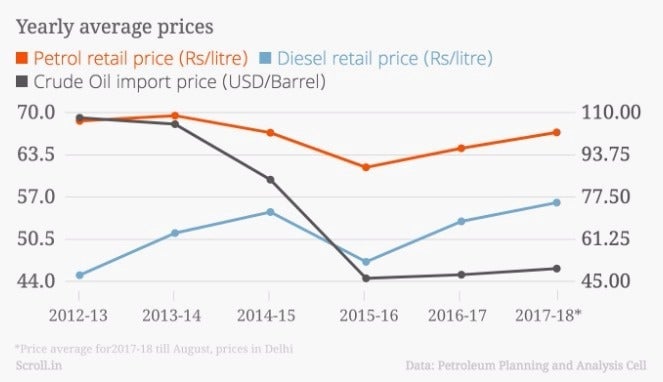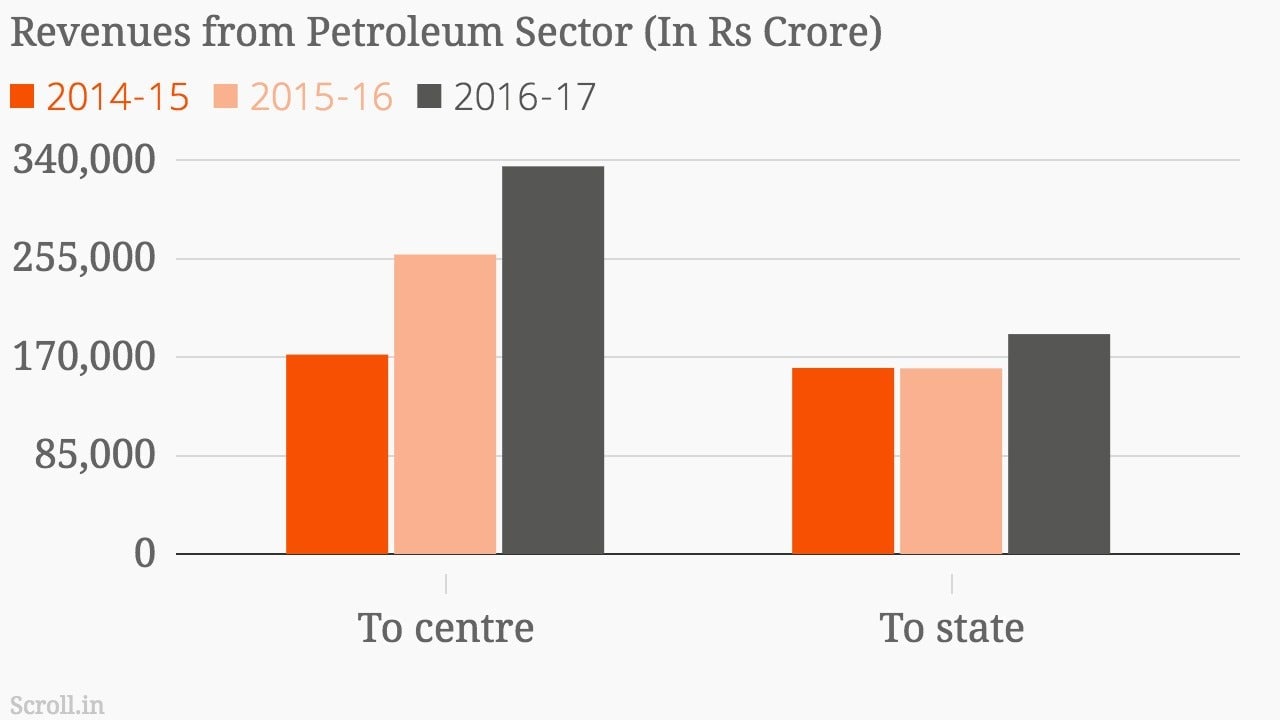The Modi government is damned if it cuts oil prices—and damned if it doesn’t
In 2011, when the cost of oil being imported by India was averaging above $100 per barrel (Rs6,430 at the current rate), the retail price that citizens paid for petrol in Delhi averaged at Rs65 per litre. But today, when the cost of importing oil is substantially lower at an average of $50 per barrel—half of that prevailing in 2011—why are consumers required to pay above Rs70 per litre of petrol? Shouldn’t the retail price of oil products, both petrol and diesel, come down somewhat, if not proportionately?


In 2011, when the cost of oil being imported by India was averaging above $100 per barrel (Rs6,430 at the current rate), the retail price that citizens paid for petrol in Delhi averaged at Rs65 per litre. But today, when the cost of importing oil is substantially lower at an average of $50 per barrel—half of that prevailing in 2011—why are consumers required to pay above Rs70 per litre of petrol? Shouldn’t the retail price of oil products, both petrol and diesel, come down somewhat, if not proportionately?

Potentially, yes. The Bharatiya Janata Party (BJP)-led government could reduce the prices. But the crisis in the economy has tied its hands. A good part of the blame for the economic crisis lies with the government and the rest on global economic trends.
Why are the costs of petrol and diesel high in India?
India imports above 80% of its crude oil requirement. So, the cost of imported oil is critical. This crude oil is then refined. The refineries add the cost of refining and their profit margin to the cost of the oil and sell it onwards to oil marketing companies such as the Indian Oil Corporation. These firms, in turn, stack up their costs of selling fuel and their profit margin, and supply petrol and diesel to retail petrol pump owners. Retail pump owners are allowed a fixed profit margin when selling to consumers. But taxes imposed by the central and state governments are also added to this topped up price.
Just over 50% of the price consumers pay for petrol is taxes that go to the centre and state. The tax rates imposed by the centre and state on the production and sale of petrol and diesel have risen over the last two years.

What could the government potentially do about the soaring prices?
There are two ways the government could reduce prices of fuel in India. It could either ask oil marketing companies that sell oil to petrol pumps to reduce their sale prices. Or, it could reduce the taxes it imposes on the sale of oil products such as petrol and diesel.
Why it is unwilling to ask oil companies to sell at a lower price to petrol stations?
Asking oil companies to shave off their profits could be tricky for the economy in the long run. It would also be the undoing of a bold policy move that the BJP-led government made when it took over power at the centre in 2014.
For a long time, as global prices of crude oil shot up, the Indian oil producing and marketing companies were asked to sell their products—such as diesel and petrol—at prices lower than those prevailing internationally. These companies still made profits but the profits were not enough to help them provide resources to add capacities to meet a future growth in demand. The difference between prevailing international prices and the price Indian oil producing and marketing companies were asked to sell at was called “under-recoveries”—a smart phrase for a notional loss. Remember, India has heard this phrase before in connection with the coal scam.
The government paid the oil companies for some of this notional loss, and the oil refiners and marketing companies bore the rest on their own. By 2012-13, the “under-recoveries” of the oil marketing companies stood at Rs92,061 crore—almost 40% of the total government subsidy payout for the year.
Though there has been a lot of criticism on how the “under-recoveries” of the oil companies are inflated because of the formula used to calculate what is only a notional loss, when Narendra Modi became the prime minister, his government decided to deregulate prices and let oil marketing companies fix the prices as per the market rates.
This would bring down the burden on the government to subsidise the oil marketing companies.
The government and the oil companies also hit a lucky patch. Global oil prices have fallen over the last three years. With increased retail prices and the lower cost of importing crude oil, oil companies were able to wipe off their notional losses even faster.
But now, over the past few months, crude oil import prices have begun to rise again. The increase in domestic taxes over the last two years riding on top of costlier oil imports are working in tandem to take the prices of oil products higher for consumers.
If at this stage, oil companies were to reduce their profit margins, their long-term ability to meet the future demand for oil would be reduced. At another level, this would postpone the chances of petrol and diesel markets being deregulated completely to ease entry of private companies into this sector in full force—they will only do so if public sector oil companies are not benefitting from government support.
Why not reduce the taxes on petrol and diesel instead?
The government could do this, but it is in a tight spot.
The economy is sliding down a deep trough at the moment. Last month, government statistics showed that India’s gross domestic product growth had slowed to 5.7% in the first quarter of 2017, from 7.9% in the corresponding period last year. The government has had to manage two successive droughts of 2014 and 2015. The government’s ill-conceived and badly-implemented demonetisation exercise, along with its hasty rollout of the goods and services tax (GST) in July has delayed a potential economic recovery.
This year again, the monsoon has ditched the unirrigated parts of the country. That promises to make economic recovery slower even as India tackles the fallout of private sector failing to repay its previous loans and consequently being unable to take new ones and invest the money productively. Exports, which make up a fifth of the country’s economy, have also fallen. Experts are divided if this is because of the high exchange rate of the rupee or global demand of Indian goods drying up, or both.
A bad economy also means lower tax collections for the government. Revenues from taxes on oil make up a substantial part of the government kitty—both for the centre and the state. Though over the past three years the centre has tweaked the tax classification and slabs to keep a higher proportion of the total revenue from the petroleum sector at the cost of the states’ share.
In 2016-17 the Union government earned Rs2.43 lakh crore from excise duty on oil—this was 2.45 times the amount it earned in 2014-15. The total revenue the government earned from oil companies in 2016-17, which includes dividends and taxes from oil marketing companies, was also nearly double the amount earned in 2014-15.
The centre subsequently transfers 42% of the revenue from excise and other taxes which are not classified as cess to the states. Even then, states’ tax receipts from the petroleum industry remain lower than the net tax and non-tax revenues the centre earns from the industry.

Perhaps aware that the implementation of the GST would hit economic activity this financial year, the government had anyway projected just a 5% growth in indirect tax collections (which includes taxes on petroleum) compared to 2016-17 actuals. Compare this with the 35% growth in indirect tax collections the government had registered in 2016-17 over the year before that. Now with even this 5% growth in indirect tax collections being an uphill task, the government is unwilling to further reduce revenues from petroleum sales so far.
A flip-side to the story
There is one persistent reason why structurally Indian governments of all hues have taxed petroleum products higher than many other countries. In comparison to the tax incidence of over 50% in India, on average the state and central taxes add up to around 17% of the price of petrol (called gasoline in the US). But then, the US is not comparable to India in its economics or its geopolitical heft, which is essential to set the energy security matrix of a country.
High taxes artificially reduce the demand for oil products in India—a necessary tool to ensure oil security for the country, though it comes at the cost of poorer sections of society. But reducing taxes substantially would lead to a sharp rise in demand for petrol and diesel, which in turn could mean a heavy import bill for the government, and a spike in global oil prices as well.
The flip-side is that a further increase in prices of diesel (not so much petrol) will lead to the increase in the prices of other goods in the market, as diesel is the fuel used to transport goods. A rising inflation rate at this juncture, when unemployment is high, the economy slack, and domestic demand shrunk, is bound to hurt people more.
The opposition parties have caught onto this and have begun to use rising petrol and diesel prices as an issue that people can relate to instead of talking of the entire set of factors that are grinding the economy right now. This, in turn, is limiting the BJP government’s wiggle room on oil prices.
The opposition smells the opportunity. After all, before 2014, the BJP, a much better-organised and more charged opposition, had been even more shrill in its rhetoric against oil prices under the previous Congress-led United Progressive Alliance government when it let the market determine petrol prices in 2010, though not diesel.
This post first appeared on Scroll.in. We welcome your comments at [email protected].